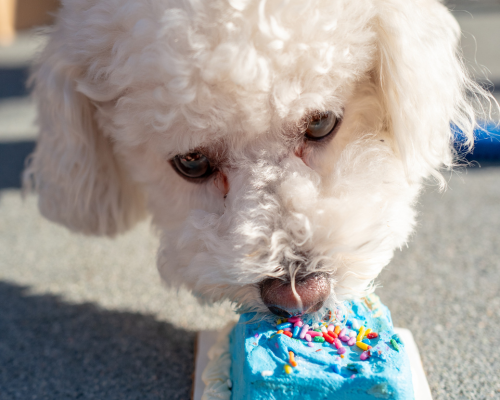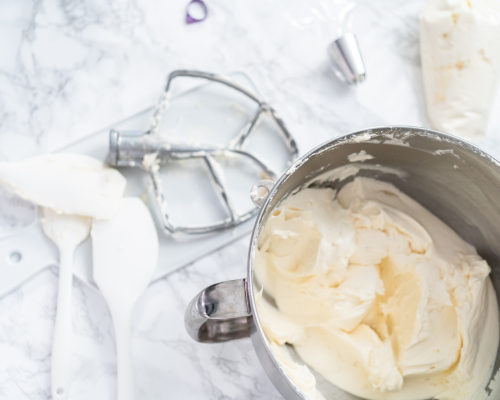Can Dogs Have Frosting (Icing)? What You Need To Know!
Can Dogs Have Frosting (Icing)? What You Need To Know!

Vet Reviewed

By: Sarah Hodgson
December 23, 2023
- Posted in Can Dogs EatDogs
Table of Contents
Whether it's having a party, or a simple birthday celebration what better way to celebrate these special occasions than with a delicious cake topped with sweet, tempting frosting? But before you go ahead and share that slice of cake full of frosting with your dog, no, you shouldn't as it is not safe.
In this article, we will explore exactly why frosting isn't safe for your dog.
So let's dive in!
What Is Frosting Made Out Of?
Frosting, also known as icing, is a sweet mixture that is typically used to decorate cakes, cookies, and other baked goods. I'm sure you've seen it and most likely tasted it.
It is made from a combination of ingredients such as powdered sugar, butter, or shortening, and flavorings such as vanilla or chocolate. Frosting is often whipped to create a light and fluffy texture that adds a tasty looking touch to desserts.
So is it safe for dogs?
The Ingredients In Frosting and Why They're Bad For Dogs
Before we dive into whether frosting is safe for dogs. Let's take a closer look at some of the common ingredients found in frosting and why they can be harmful to dogs:
Sugar
One of the most common if not the most used ingredient in frosting. A lot of sugar consumption can lead to obesity, dental issues, and diabetes in dogs. It can also contribute to hyperactivity and provide empty calories with no nutritional value. So it has no benefits.
Artificial Sweeteners
Artificial sweeteners like xylitol are highly toxic to dogs, even in small amounts. They can cause a sudden drop in blood sugar levels, leading to severe health problems.
Chocolate
Not always found in frosting but if it is even small amounts can cause symptoms ranging from mild gastrointestinal upset to life-threatening conditions.
Butter or Shortening
These ingredients are high in fat and can contribute to pancreatitis, a painful inflammation of the pancreas. Pancreatitis can lead to serious health complications for dogs.
Artificial Colors and Preservatives
These additives can trigger allergic reactions in dogs, causing symptoms such as itching, rashes, and gastrointestinal upset.

Can Dogs Eat Frosting?
So now to our main question, can dogs have frosting?
While dogs may be tempted by the sweet aroma and creamy texture of frosting, it is not recommended to feed them frosting. While it's not toxic in most scenarios it has no health benefits and will likely be harmful.
Now while a lick or two of frosting certainly won't have any effect on your dog. Too much can cause some harm so it's best to stay away and give your dog homemade frosting.
As we mentioned earlier, the high sugar content in frosting can lead to a variety of health problems for dogs, including obesity, dental issues, and even diabetes or pancreatitis. Moreover, some of the other ingredients commonly found in frosting can be harmful to dogs, such as artificial sweeteners and chocolate.
Can Dogs Eat Sugar-Free Frosting?
You might be tempted to think that sugar-free frosting would be a safer alternative for your dog as you might think that sugar might be the only bad ingredient.
Sugar-free frostings contain artificial sweeteners, such as xylitol, which can be highly toxic to dogs. Xylitol can cause a sudden release of insulin in dogs, leading to a dangerous drop in blood sugar levels. So don't feed your dog sugar-free frosting.
This can result in symptoms such as vomiting, seizures, and even liver failure. Therefore, it is important to avoid giving your dog any type of frosting, whether it is sugar-free or not.
Is Frosting Bad For Dogs?
So to sum up, Yes, frosting is bad for dogs. In addition to the high sugar content and potential presence of artificial sweeteners, frosting can also contain other harmful ingredients such as chocolate, which is toxic to dogs.
Chocolate contains theobromine, a compound that can cause symptoms ranging from mild gastrointestinal upset to more severe conditions like tremors, seizures, and even heart problems. The darker the chocolate, the higher the concentration of theobromine, making it even more dangerous for dogs.
Furthermore, frosting often contains butter or shortening, which can be high in fat and lead to pancreatitis in dogs. Pancreatitis is a painful inflammation of the pancreas that can cause symptoms such as vomiting, abdominal pain, and decreased appetite. Additionally, some frosting varieties may contain artificial colors and preservatives, which can trigger allergic reactions in dogs.

What to Do If Your Dog Eats Frosting?
If your dog accidentally eats frosting, don't panic. In most cases, if your dog just takes a couple of licks of frosting he should be fine. However, if you suspect that he might have bitten a large part of it follow the steps below:
First, assess the situation and determine the amount and type of frosting ingested. If you suspect your dog has eaten a large amount of frosting or if it contains chocolate or artificial sweeteners monitor your dog.
Some signs you might see if your dog ate frosting include:
- Vomiting
- Diarrhea
- Lethargy
- Restlessness
- Increased Thirst
- Difficulty Breathing
- Increased Heart Rate
- Tremors or Seizures
- Loss of Coordination
- Changes in Behavior
If you notice any of these signs you should contact your vet. They will assess the situation and provide appropriate advice based on your dog's specific circumstances.
How To Make Dog-Safe Frosting?
If you still want to treat your dog to a special dessert, with a nice-looking icing top there are dog-safe frosting alternatives that you can make at home.
Here's a simple recipe you can make the is safe for your dog:
Ingredients:
- 1 cup unsweetened applesauce
- 1 cup plain Greek yogurt
- 1 tablespoon honey
- 1 teaspoon vanilla extract
Instructions:
- In a mixing bowl, combine the unsweetened applesauce, plain Greek yogurt, honey, and vanilla extract.
- Stir the ingredients together until well combined and smooth.
- Once your dog-friendly frosting is ready, you can use it to top homemade dog treats or even freeze it to create refreshing frozen treats for hot summer days.
Note
Keep in mind to serve these homemade dog-friendly frostings in moderation and as an occasional treat. They should not replace any real diet foods.

The Bottom Line
So there you have it, while the idea of sharing a slice of cake with your dog may seem tempting, if it contains frosting you should not.
Remember, a little love and attention go a long way in keeping your dog happy and healthy. So next time you celebrate, consider including your dog in the festivities with a special treat made just for them.
Frequently Asked Questions
How much frosting is safe for dogs to have?
The key is moderation. A small amount as an occasional treat is generally safe. However in most cases just stay away from frosting when it comes to dogs.
Can frosting lead to obesity in dogs?
Yes, excessive consumption of frosting can contribute to obesity in dogs because of its high calorie and sugar content.
Should frosting be completely avoided for all dogs?
While certain types of frosting can be harmful, small amounts of safe alternatives can be given as an occasional treat. However, it's essential to prioritize a well-balanced and nutritious diet for your dog.

Subscribe to Petfluence!
Get updates on the latest posts and more from Petfluence straight to your inbox.